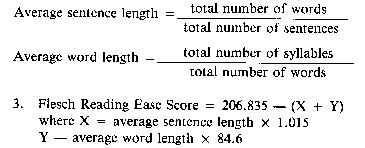§ 64.14. Approved forms.
(a) Forms presently approved by the Insurance Department for insurance within the scope of this chapter are subject to disapproval 1 year after the effective date of this section unless they comply with the requirements set forth in this chapter.
(b) If presently approved forms are believed to be in compliance with the requirements of this chapter, insurers may request confirmation from the Insurance Department.
APPENDIX A
HOW TO MEASURE READABILITY A. If the whole contract is analyzed:
1. For each sentence, count the number of words and the number of syllables.
Counting sentences—When counting sentences, go according to full units of thought, ending with a period, semicolon, or colon. Do not count headings or subsection numbers. Skip lists of items having only a few words.
Counting words—Contractions and hyphenated words are counted as one word. So are numbers and letters, if they are separated by spaces. For example, ‘‘C.O.D.’’ and ‘‘19’’ would each be considered one word.
Counting syllables—Count as syllables pronounce, even for numbers and letters, if they are not too lengthy. If numbers and letters (such as ‘‘PA-1943D’’) are too lengthy, skip them. Where the dictionary shows two or more equally acceptable pronunciations of a word, use the one having the fewer number of syllables.
An easy way to count words and syllables is to write down the number of syllables in each word as you read the sentences. To get the number of words, count the numbers written down. To get the number of syllables, add the numbers written down.
To simplify counting the number of words, use graph paper scaled every 5 or 10 spaces.
To simplify adding up the number of syllables, total up the syllables, other than the first, in all words of more than one syllable. Then add this total to the number of words being tested.
2. Add up the total number of sentences, words, and syllables for the whole contract.

B. If samples are used
1. Sampling—It will often be too time-consuming to analyze all the sentences in a contract. Choose samples of about 100 words by using all sentences up to and including the sentence ending after the 100-word mark. For example, the last sentence in the sample might end on the 105th or 115th word of sample; i.e., count 100 words and then finish the sentence.
To insure an unbiased sample, use the following system:
a. For small contracts of one or two pages, do not use samples. Instead, analyze the whole contract.
b. For larger policies, take about two samples per page.
c. Skip an equal number of printed lines after each sample and start the next sample with the sentence beginning after that point. To determine the number of lines between samples, take two samples from page 1 and count how many lines are between them.
For example, suppose there were 50 printed lines between the first two samples. Then after each sample, count 50 lines, and start the next sample with the sentence beginning after that 50-line point.
If a row of print is less than one-half the column of print, do not count it.
2. For all the sentences in the samples, follow the same procedure as in items A-1, 2, 3.
SUBMITTING INFORMATION ON READABILITY For each policy analyzed by the Flesch Readability Method, please submit the following:
A. If the whole contract is analyzed:
1. Summary of information for each sentence—number of words and number of syllables.
2. Calculation of Average Sentence Length, Average Word Length, and Flesch Reading Ease Score.
B. If samples are used:
1. Description of Sampling method—number of samples, number of printed lines between samples, and marked copy of policy indicating samples.
2. Summary of information for each sample—number of sentences, number of words, and number of syllables.
3. Calculation of Average Sentence Length, Average Word Length, and
Flesch Reading Ease Score.
Example:
If samples are used:

C. Because of their effect on readability, each filing submitted should list the number of times each of the following words or phrases is used for calculating the Flesch Score on each policy:
‘‘accident’’
‘‘bodily injury’’
‘‘company’’
‘‘insurance’’
‘‘liability’’
‘‘damage’’
‘‘policy’’
‘‘property damage’’
No part of the information on this site may be reproduced for profit or sold for profit.
This material has been drawn directly from the official Pennsylvania Code full text database. Due to the limitations of HTML or differences in display capabilities of different browsers, this version may differ slightly from the official printed version.